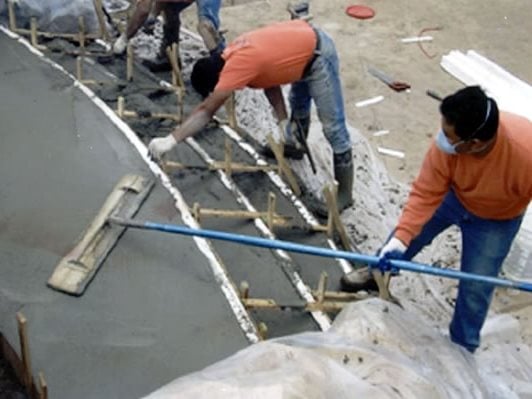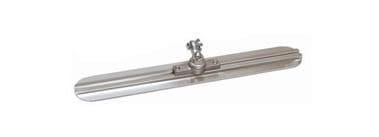- Concrete Tools Home
- Screeds
- Tampers
- Concrete Floats
- Concrete Edgers
- Groovers
- Trowels
- Fresnos
- Power Tools for Concrete
- Choosing the Best Tool for the Job
- Must-Have Tools for Exterior Concrete: The five tools outdoor concrete contractors can’t live without
- Five Must-Have Tools for Decorative Flooring Contractors Create eautiful decorative concrete floors with these five tools
- Five Must-Have Tools for Concrete Countertop Contractors
- Related Information:
- Pouring and Finishing Tool Videos: See demonstrations of floating, troweling, edging, and more
- Concrete Finishing Tips: Creating a high-quality slab
- Product Newsletter: Sign up today to receive monthly updates
Concrete Finishing - How To Tips for Slabs
How to finish a concrete slab, from spreading to troweling
Concrete finishing is easier with a crew that can work as a team. Decorative Concrete Institute in Temple, GA
Concrete finishing is a process that strives to create a smooth, durable surface. When finishing concrete, timing is crucial and you must pay close attention to the condition of the concrete. Improper finishing techniques can lead to a weak, damaged or unattractive slab.
CONCRETE FINISHING TOOLS
Once you’ve formed and poured the concrete you’re ready to start the finishing process.
Here are the tools you will need for this job:
- Square shovel or come-along
- Screed or straight board
- Bull float or darby
- Edging tool
- Concrete groover
- Steel trowel or fresno
Need finishing help? Find concrete contractors near me.
Placing & Finishing Concrete
Time: 06:03
See the process of placing, screeding, floating, and finishing a concrete slab.
HOW TO FINISH CONCRETE
Once you have your tools, you're ready to get started. Here are the steps for finishing a concrete slab:
Spread the concrete
Use a square shovel or a come-along tool to push and pull the wet concrete into place.Screed the concrete
During this step remove excess concrete and bring the surface of the concrete to proper grade. Use a straight board or special tool called a screed.Float the surface
Use a darby or bull float to level ridges, fill voids and slightly embed the aggregate. Then allow the bleed water to disappear.Edge the slab
Once all the bleed water is gone, create neat rounded edges along the perimeter of the slab using an edger.Groove in joints
Prevent unwanted cracks by jointing the slab with a grooving tool.Trowel the surface
If you’re looking for a smooth, hard, dense surface, use a steel trowel or fresno for this step. Skip troweling if you plan to broom finish your concrete or add a decorative finish.
 Encore Finishing Aid
Improve workability and surface quality
Encore Finishing Aid
Improve workability and surface quality
 Kraft Concrete Float 24" x 3.25"
Lightweight magnesium float for small areas
Kraft Concrete Float 24" x 3.25"
Lightweight magnesium float for small areas
 DAY1® Finishing Aid
Colloidal silica for easy, fast finishing
DAY1® Finishing Aid
Colloidal silica for easy, fast finishing
CURE AND SEAL THE CONCRETE
Once you’re done with finishing, let the concrete dry and achieve full strength, this is called curing. You can use your concrete for light foot traffic 3 to 4 days after placement, and you can drive and park on your concrete after 5 to 7 days, but curing isn’t complete until the 28 day mark. Once the concrete is fully cured, apply a protective sealer to prevent stains and prolong the life of your slab.
CONCRETE FINISHING TIPS AND TRICKS
Come-a-Long Tool Demonstration
Time: 01:56
Learn the proper use of using a come-a-long tool.
A good finisher is produced through training and years of experience. Books have been written about this topic, and only experience provides the ability to expertly "time" the finishing operations.
To give you a head start, here are finishing tips from the pros:
- Place the concrete as close as possible to its final destination (concrete weighs approximately 150 pounds per cubic foot).
- Excess handling can cause segregation of the course and fine aggregates.
- Wetting up the concrete so it can be raked or pushed into a location far from where it is discharged is not acceptable.
- Do not use a round edge shovel for spreading concrete since it does not spread the concrete evenly.
- "Strikeoff" or screed the concrete as close as possible to its final plane.
- Don't tamp high slump concrete.
- Bull floating should be finished before excess moisture or bleedwater appears. When floating, lift the leading edge slightly off the concrete surface.
- Don't fresno the slab right after screeding - bleedwater and air trapped beneath the sealed surface will create blisters that later break or a weakened plane that causes sheet delamination.
- Dont finish the concrete while there is bleedwater on the surface. Using a finishing tool while there is water on the surface increase water-cement ratio by working the water back into the concrete instead of letting it evaporate. This can cause dusting, scaling and craze cracking.
Read other tips on Building a High Quality Slab on Grade.




